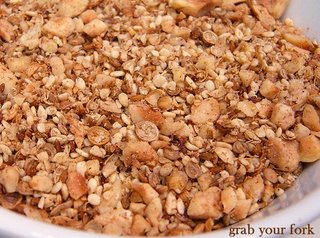How to Make Your Own Dukkah

Dukkah is the new chevre, if its unfailing presence at Sydney farmers' markets is any indication. This tumble of nuts and seeds may not appear appetising, but one crunch of the stuff is enough to make your nose ooh at the roasted aromas, your tongue tingle at the multiple textures, and your tastebuds sigh at the nutty goodness with which it has been blessed.
A traditional Egyptian spice, the ingredients for dukkah remain at the carefree whim of the spice-grinding chef. Usually it contains hazelnuts, although sometimes there may be macadamias, chickpeas, pistachios or almonds. Essential partners include the ground-up seeds of sesame, cumin and coriander.
This was my first attempt at making dukkah, an ambition buoyed by the optimistic belief that surely it couldn't be that hard to make, and cemented by the mental calculation of its price per kilo versus the raw ingredient price if I made it myself (ie. I am cheap). The first recipe I tried was from Stephanie Alexander's Cook's Companion which ended up very cumin-y and not very hazelnutty, so I made some significant tweaks, mainly adding a lot more hazelnuts. I'm still not totally happy but it'll do for now. It's the kind of thing that every person will want, and should, adjust to personal taste.
Dukkah
1 cup hazelnuts
1/2 cup sesame seeds
1 tablespoon coriander seeds
1 tablespoon cumin seeds
freshly ground black pepper
sea salt
Roast the hazelnuts in the oven at 350F / 175C for about five minutes taking care they don't burn. Whilst they are hot, rub with a tea towel to remove any excess skin and allow to cool.
In separate batches, dry roast the same seeds, coriander seeds and cumin seeds in an unoiled frypan until fragrant.
Using a food processor, grind the seeds to a coarse textured consistency (or as you prefer). Do the same with the hazelnuts, taking care to pulse the processor as a precaution (you don't want hazelnut butter). I like my hazelnuts extra chunky but maybe that's just because I'm prone to greed.
Combine ingredients in a bowl and season to taste. Adjust ingredients if necessary.
~~~
How to eat dukkah
Most people enjoy dukkah as a dip. Dip fluffy wads of fresh turkish bread into olive oil (white side down) and then dip into a bowl of dukkah mixture for a crunchy coating. I've been using avocado oil with great success, as it adds a creamy, almost sweet flavour. Dukkah and bread is quick for easy snacking and classy enough for any socialite's pre-dinner party nibbles.
Dukkah can be used as a rub, marinade or crust for chicken, fish or lamb. Or it can be scattered on pizza bases, rice, eggs, noodles, pasta, vegetables, crudites and salads. Okay, it goes with anything. And everything. I'd stick with savoury though.
posted by Anonymous on 7/17/2006 11:35:00 pm





6 Comments:
At 7/19/2006 10:05 am, Ange said…
Ange said…
I love this stuff which so far I have only bought & not made my own. And the best way is definitely with bread & olive oil, I think I could do a whole loaf! Also really good on fish
At 7/19/2006 7:22 pm, Anonymous said…
Anonymous said…
A bit of dukkah is a fine, fine thing. Mind you, when I say a bit, I must admit to being able to eat a LOT of it.
I haven't yet perfected my own recipe, but I am a big fan of Herbies' Okkah - ie Australian dukkah. I know, I know it's an appalling name, but it's really good - the usual dukkah things plus akudjura, wattleseed, cumin seeds and native pepperberry.
At 7/24/2006 7:57 am, Reb said…
Reb said…
I LOOOOOOVE Dukkah too and make it all the time. For the dip, try aromatic mustard seed oil - it gives it a kick. For meats, I roast Frenched racks of lamb with Dukkkah pressed on the uppermost side - divine!
At 11/11/2006 11:19 pm, Anonymous said…
Anonymous said…
I added sugar in my own recipe, as it was an ingredient listed in a dukkah I bought in London.
At 9/15/2007 12:33 pm, SteamyKitchen said…
SteamyKitchen said…
Avocado oil is a great idea!
At 9/17/2007 9:27 pm, Helen (Grab Your Fork) said…
Helen (Grab Your Fork) said…
Hi SteamyKitchen - I love avocado oil :) I had some drizzled on pasta just today
Post a Comment
<< Home